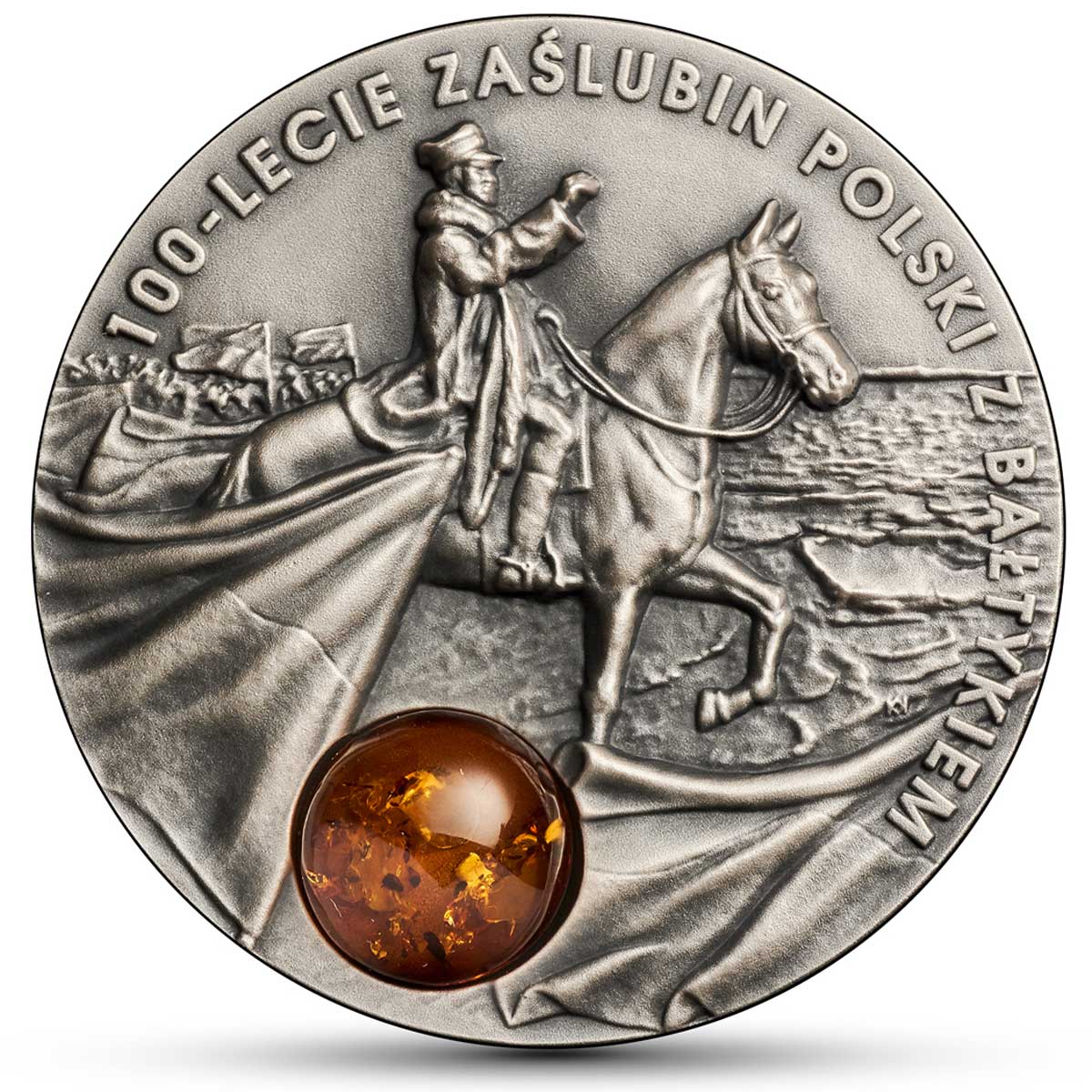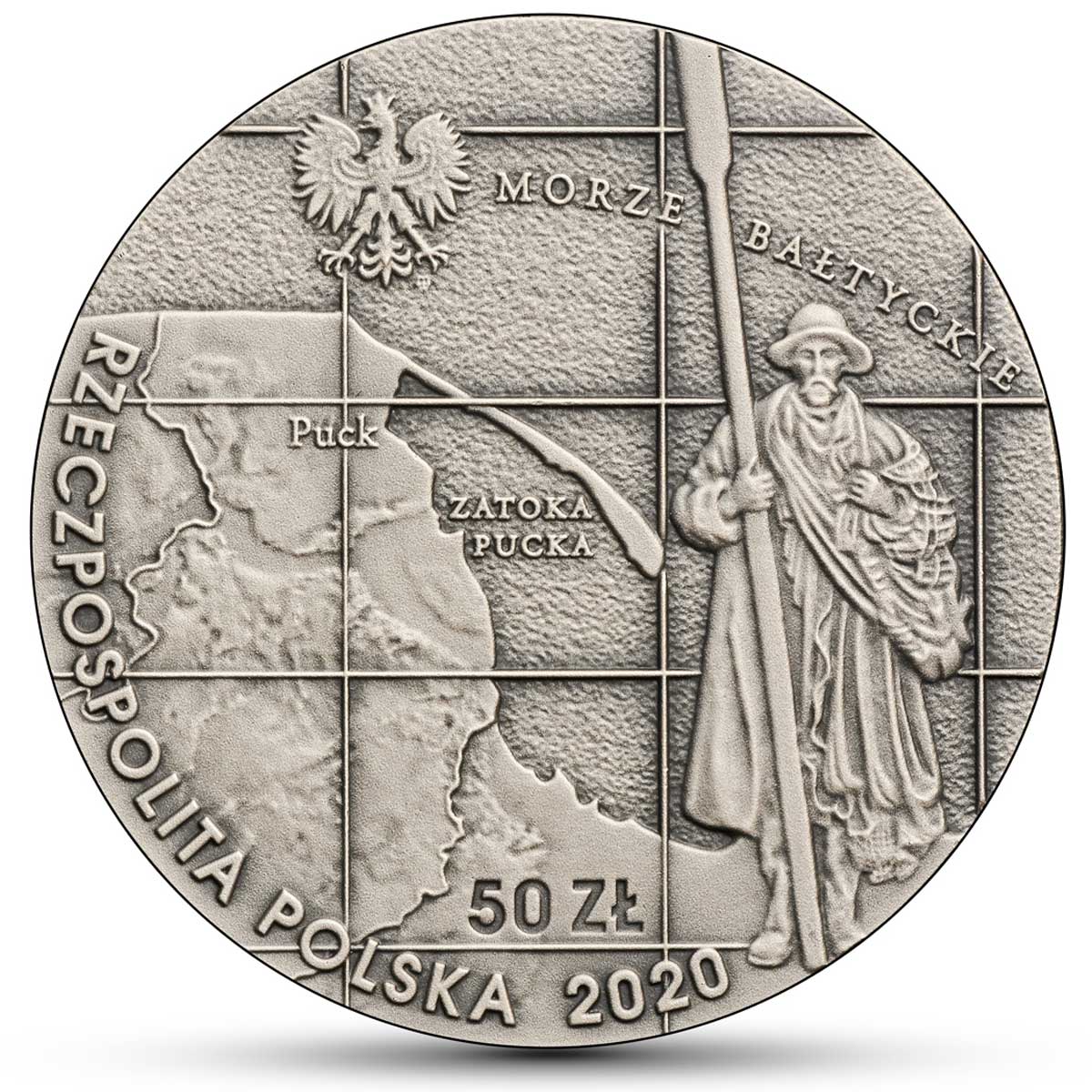General Joseph Haller’s symbolic ride into the sea marked on new Polish silver coin
Poland seems to love its history coins more than most and the National Bank of Poland (NBP) issues some quite esoteric examples. There are quite a few centennial coins of late, buoyed by the period around one hundred years ago being one of crucial importance in the foundation of the modern state of Poland and its effect on 20th century conflict.
The coin we’re looking at here isn’t your typical NBP issue, who tends to specialise in the sub-1oz sterling silver format, usually cleanly struck, but sometimes with some colour. Their coins are struck by the Mint of Poland, someone we’re sure you know is associated with more ambitious fare, but in this case the finished article is very much in the Mint of Poland’s sphere of influence.
Struck in two ounces of 0.999 silver to a high-relief and with an antique finish, this coin celebrating Poland’s access to the Baltic Sea in 1920 is quite different to the NBP’s usual, and the addition of an amber half-sphere on the reverse face makes that extra clear. Despite that, the underlying design is very much a product of Polish history, depicting General Joseph Haller’s ride into the sea to deposit a platinum ring in celebration of Poland’s reformation and access to the sea. Baltic amber is quite famous, so its inclusion here is symbolic.
The obverse face has a map of the area, on top of which is a period fisherman. The coin has nods to that time over both faces and fortunately, the NBP provides plenty of backstory to explain the subject, which we’ve reproduced below. What’s important to us is the finished article, and it’s a nice coin, very much in keeping with the style of this producer. Available to order now, with a mintage of 5,000 pieces. It comes boxed with a C.O.A.
MINTS DESCRIPTION
Republic of Poland by the Baltic Sea: The collapse of the partitioning states after World War I, the actions of Poles in exile and the fights of Polish military units on all fronts were the basis of Polish independence. Its form was influenced by Western politicians. “A free and secure access to the sea”, as we can read in the 13th point of the speech by the President of the United States Thomas Woodrow Wilson of 8 January 1918, was sealed in the provisions of the Treaty of Versailles. When, after 11 November 1918, the fighting for the borders of the reborn state dragged on, in the former Royal Prussia and Gdańsk Pomerania the effort was focused on wrestling a corridor to the Baltic Sea from the German grip. Admiral Kazimierz Porębski, the initiator of the “maritime consciousness” awakening in the Polish society, won great merits in this respect, whereas General Józef Haller, commander of the Pomeranian Front, took over from Germans on behalf of the Republic of Poland the part of Pomerania conceded to Poland by the Allies.
Wedding to the Sea – opening to the world: On Tuesday, 10 February 1920, at about 10.00 am, a special Polish train set off from Gdańsk to Puck. The journey took four and a half hours! A correspondent of “Gazeta Gdańska” newspaper reported that in front of their train moved a gorgeous locomotive that could not somehow reach Wrzeszcz (the part of Gdańsk). This German sabotage had no effect on the outcome of the undertaking. Delegations came to Puck from all over Poland. “Masses of people and army” in pouring rain, “amid the firing of cannons” reached the “airfield” where a chapel was improvised. The Polish flag was raised on the flagpole and a Holy Mass was celebrated. “We welcome you, our Polish sea, and we take you into our possession” – these were the final words of the sermon given by the reverend Józef Wrycza. A commemorative post with the Polish flag on it was placed on the seashore.
Józef Haller and the ring: General Joseph Haller rode into the sea on horseback. On behalf of the Republic of Poland he threw into the water a platinum ring received from Polish Danzigers and concluded the ceremony with words: “Here is the day of reverence and glory. The White Eagle has spread its wings not only over the Polish lands but also over the Polish sea. The nation feels that it is no longer being strangled by the hydra, which has so far been wrapped around its neck and breasts. Now free worlds and free nations stand open before us. Now a Polish sailor will be able to reach everywhere under the banner of the White Eagle. The whole world is open to him”.
Wedding to the sea – beginning of a success story: On the initiative of Admiral Porębski, a nationwide “maritime movement” was organised. New organisations were formed: from the Stowarzyszenie Pracowników na Polu Rozwoju Żeglugi “Bandera Polska” (Association of Workers in the Field of Shipping Development) established in 1918 to the Maritime and Colonial League founded in 1930. Polish Pomerania, only 140 km of coastline including the Hel Peninsula, became the area of a great civilizational experiment. In order to make Pomerania independent from the Free City of Gdańsk, which was hostile to Poland, almost everything was built from scratch. This experiment had as its flagship the city of Gdynia Face and it has contributed to the growth of the entire
national economy, including the country’s defence and tourism industries. Nowadays, the shore of the Baltic Sea in Puck is decorated with a commemorative post with the Jagiellonian eagle and the inscription “Roku Pańskiego 1920, 10 lutego Wojsko Polskie z generałem Józefem Hallerem na czele objęło na wieczne posiadanie polskie morze” (In the year of our Lord 1920, on 10 February the Polish Army with General Józef Haller at the head of the troops took the Polish sea into eternal possession).
Explore the coin: The obverse shows the recovered part of Pomerania, delimited by the adjoining German territory, and a Kashubian fisherman with a long oar, characteristic for the region and historical period, and with a coil of nets. The reverse shows General Józef Haller entering the waters of the Puck Bay on horseback in the symbolic act of wedding to the sea. The background depicts a stylised patriotic manifestation on 10 February 1920, with a strong national accent – Polish state flags waving aloft. The amber insert emphasises the maritime character of the coin. Jan Tarczyński, PhD
| SPECIFICATION | |
| DENOMINATION | 50 Zloty (Poland) |
| COMPOSITION | 0.999 silver |
| WEIGHT | 62.2 grams |
| DIMENSIONS | 45.0 mm |
| FINISH | Antique |
| MODIFICATIONS | High relief, Amber |
| MINTAGE | 5,000 |
| BOX / C.O.A. | Yes / Yes |





Leave A Comment